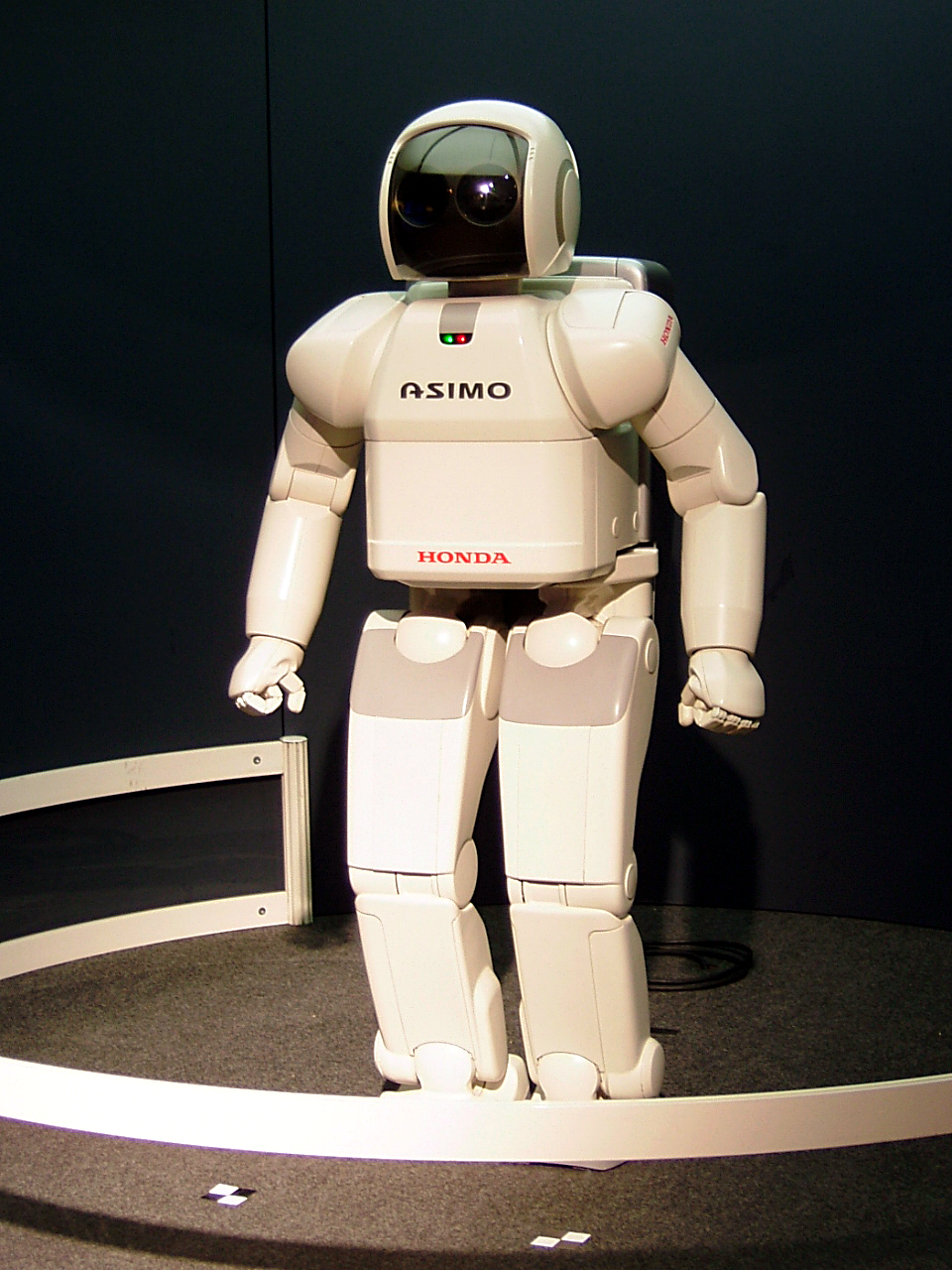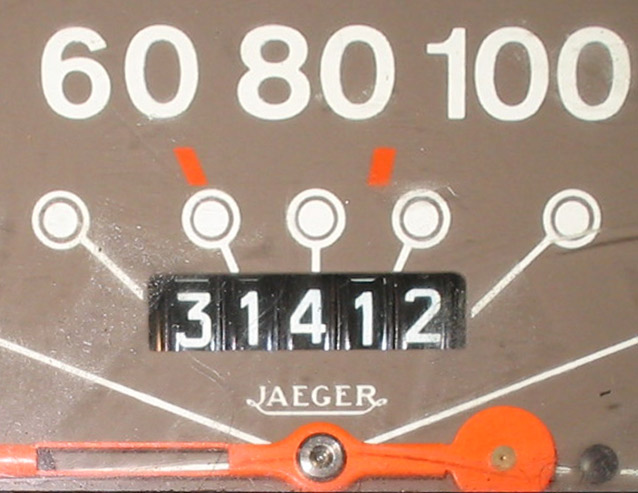|
Allen (robot)
Allen was a robot introduced by Rodney Brooks and his team in the late 1980s, and was their first robot based on subsumption architecture. It had sonar distance and odometry on board, and used an offboard lisp machine to simulate subsumption architecture. It resembled a footstool on wheels. Allen used three layers of control which are implemented in subsumption architecture. "The lowest layer of control makes sure that the robot does not come into contact with other objects." Due to this layer it could avoid static and dynamic obstacles, but it could not move. It sat in the middle of the room, waiting for obstruction. When the obstruction came, Allen ran away, avoiding collisions as it went. It used following internal representation, and every sonar return represented a repulsive force with, and inverse square drop off in strength. Direction of its move was obtained by sum of the repulsive forces (suitably thresholded). It possessed an additional reflex which halted it whenever it ... [...More Info...] [...Related Items...] OR: [Wikipedia] [Google] [Baidu] |
Robot
A robot is a machine—especially one Computer program, programmable by a computer—capable of carrying out a complex series of actions Automation, automatically. A robot can be guided by an external control device, or the robot control, control may be embedded within. Robots may be constructed to evoke Humanoid robot, human form, but most robots are task-performing machines, designed with an emphasis on stark functionality, rather than expressive aesthetics. Robots can be autonomous robot, autonomous or semi-autonomous and range from humanoids such as Honda's ''Advanced Step in Innovative Mobility'' (ASIMO) and TOSY's ''TOSY Ping Pong Playing Robot'' (TOPIO) to industrial robots, robot-assisted surgery, medical operating robots, patient assist robots, dog therapy robots, collectively programmed Swarm robotics, ''swarm'' robots, UAV drones such as General Atomics MQ-1 Predator, and even microscopic Nanorobotics, nanorobots. By mimicking a lifelike appearance or automating mo ... [...More Info...] [...Related Items...] OR: [Wikipedia] [Google] [Baidu] |
Rodney Brooks
Rodney Allen Brooks (born 30 December 1954) is an Australian robotics, roboticist, Fellow of the Australian Academy of Science, author, and robotics entrepreneur, most known for popularizing the behavior based robotics, actionist approach to robotics. He was a Panasonic Professor of Robotics at the Massachusetts Institute of Technology and former director of the MIT Computer Science and Artificial Intelligence Laboratory. He is a founder and former Chief Technical Officer of iRobot and co-founder, Chairman and Chief Technical Officer of Rethink Robotics (formerly Heartland Robotics) and is the co-founder and Chief Technical Officer of Robust.AI (founded in 2019). Life Brooks received an M.A. in pure mathematics from Flinders University of South Australia. In 1981, he received a PhD in Computer Science from Stanford University under the supervision of Thomas Binford. He has held research positions at Carnegie Mellon University and Massachusetts Institute of Technology, MIT and a ... [...More Info...] [...Related Items...] OR: [Wikipedia] [Google] [Baidu] |
Subsumption Architecture
Subsumption architecture is a reactive robotic architecture heavily associated with behavior-based robotics which was very popular in the 1980s and 90s. The term was introduced by Rodney Brooks and colleagues in 1986.Brooks, R. A., "A Robust Programming Scheme for a Mobile Robot", Proceedings of NATO Advanced Research Workshop on Languages for Sensor-Based Control in Robotics, Castelvecchio Pascoli, Italy, September 1986. Subsumption has been widely influential in autonomous robotics and elsewhere in real-time AI. Overview Subsumption architecture is a control architecture that was proposed in opposition to traditional symbolic AI. Instead of guiding behavior by symbolic mental representations of the world, subsumption architecture couples sensory information to action selection in an intimate and bottom-up fashion. It does this by decomposing the complete behavior into sub-behaviors. These sub-behaviors are organized into a hierarchy of layers. Each layer implements a pa ... [...More Info...] [...Related Items...] OR: [Wikipedia] [Google] [Baidu] |
Sonar
Sonar (sound navigation and ranging or sonic navigation and ranging) is a technique that uses sound propagation (usually underwater, as in submarine navigation) to navigate, measure distances ( ranging), communicate with or detect objects on or under the surface of the water, such as other vessels. "Sonar" can refer to one of two types of technology: ''passive'' sonar means listening for the sound made by vessels; ''active'' sonar means emitting pulses of sounds and listening for echoes. Sonar may be used as a means of acoustic location and of measurement of the echo characteristics of "targets" in the water. Acoustic location in air was used before the introduction of radar. Sonar may also be used for robot navigation, and sodar (an upward-looking in-air sonar) is used for atmospheric investigations. The term ''sonar'' is also used for the equipment used to generate and receive the sound. The acoustic frequencies used in sonar systems vary from very low ( infrasonic) to e ... [...More Info...] [...Related Items...] OR: [Wikipedia] [Google] [Baidu] |
Odometry
Odometry is the use of data from motion sensors to estimate change in position over time. It is used in robotics by some legged or wheeled robots to estimate their position relative to a starting location. This method is sensitive to errors due to the integration of velocity measurements over time to give position estimates. Rapid and accurate data collection, instrument calibration, and processing are required in most cases for odometry to be used effectively. The word ''odometry'' is composed of the Greek words ''odos'' (meaning "route") and ''metron'' (meaning "measure"). Example Suppose a robot has rotary encoders on its wheels or on its legged joints. It drives forward for some time and then would like to know how far it has traveled. It can measure how far the wheels have rotated, and if it knows the circumference of its wheels, compute the distance. Train operations are also frequent users of odometrics. Typically, a train gets an absolute position by passing over stat ... [...More Info...] [...Related Items...] OR: [Wikipedia] [Google] [Baidu] |
Knowledge Representation
Knowledge representation (KR) aims to model information in a structured manner to formally represent it as knowledge in knowledge-based systems whereas knowledge representation and reasoning (KRR, KR&R, or KR²) also aims to understand, reason, and interpret knowledge. KRR is widely used in the field of artificial intelligence (AI) with the goal to represent information about the world in a form that a computer system can use to solve complex tasks, such as diagnosing a medical condition or having a natural-language dialog. KR incorporates findings from psychology about how humans solve problems and represent knowledge, in order to design formalisms that make complex systems easier to design and build. KRR also incorporates findings from logic to automate various kinds of ''reasoning''. Traditional KRR focuses more on the declarative representation of knowledge. Related knowledge representation formalisms mainly include vocabularies, thesaurus, semantic networks, axiom system ... [...More Info...] [...Related Items...] OR: [Wikipedia] [Google] [Baidu] |
Heuristic
A heuristic or heuristic technique (''problem solving'', '' mental shortcut'', ''rule of thumb'') is any approach to problem solving that employs a pragmatic method that is not fully optimized, perfected, or rationalized, but is nevertheless "good enough" as an approximation or attribute substitution. Where finding an optimal solution is impossible or impractical, heuristic methods can be used to speed up the process of finding a satisfactory solution. Heuristics can be mental shortcuts that ease the cognitive load of making a decision. Context Gigerenzer & Gaissmaier (2011) state that sub-sets of ''strategy'' include heuristics, regression analysis, and Bayesian inference. Heuristics are strategies based on rules to generate optimal decisions, like the anchoring effect and utility maximization problem. These strategies depend on using readily accessible, though loosely applicable, information to control problem solving in human beings, machines and abstract i ... [...More Info...] [...Related Items...] OR: [Wikipedia] [Google] [Baidu] |
Euclidean Vector
In mathematics, physics, and engineering, a Euclidean vector or simply a vector (sometimes called a geometric vector or spatial vector) is a geometric object that has magnitude (or length) and direction. Euclidean vectors can be added and scaled to form a vector space. A '' vector quantity'' is a vector-valued physical quantity, including units of measurement and possibly a support, formulated as a '' directed line segment''. A vector is frequently depicted graphically as an arrow connecting an ''initial point'' ''A'' with a ''terminal point'' ''B'', and denoted by \stackrel \longrightarrow. A vector is what is needed to "carry" the point ''A'' to the point ''B''; the Latin word means 'carrier'. It was first used by 18th century astronomers investigating planetary revolution around the Sun. The magnitude of the vector is the distance between the two points, and the direction refers to the direction of displacement from ''A'' to ''B''. Many algebraic operations on real numbe ... [...More Info...] [...Related Items...] OR: [Wikipedia] [Google] [Baidu] |
Artificial Life
Artificial life (ALife or A-Life) is a field of study wherein researchers examine systems related to natural life, its processes, and its evolution, through the use of simulations with computer models, robotics, and biochemistry. The discipline was named by Christopher Langton, an American computer scientist, in 1986. In 1987, Langton organized the first conference on the field, in Los Alamos, New Mexico. There are three main kinds of alife, named for their approaches: ''soft'', from software; ''hard'', from computer hardware, hardware; and ''wet artificial life, wet'', from biochemistry. Artificial life researchers study traditional biology by trying to recreate aspects of biological phenomena. Overview Artificial life studies the fundamental processes of living systems in artificial environments in order to gain a deeper understanding of the complex information processing that define such systems. These topics are broad, but often include Evolutionary algorithm, evolutionar ... [...More Info...] [...Related Items...] OR: [Wikipedia] [Google] [Baidu] |
Artificial Intelligence
Artificial intelligence (AI) is the capability of computer, computational systems to perform tasks typically associated with human intelligence, such as learning, reasoning, problem-solving, perception, and decision-making. It is a field of research in computer science that develops and studies methods and software that enable machines to machine perception, perceive their environment and use machine learning, learning and intelligence to take actions that maximize their chances of achieving defined goals. High-profile applications of AI include advanced web search engines (e.g., Google Search); recommendation systems (used by YouTube, Amazon (company), Amazon, and Netflix); virtual assistants (e.g., Google Assistant, Siri, and Amazon Alexa, Alexa); autonomous vehicles (e.g., Waymo); Generative artificial intelligence, generative and Computational creativity, creative tools (e.g., ChatGPT and AI art); and Superintelligence, superhuman play and analysis in strategy games (e.g., ... [...More Info...] [...Related Items...] OR: [Wikipedia] [Google] [Baidu] |
Distributed Artificial Intelligence
Distributed artificial intelligence (DAI) also called Decentralized Artificial IntelligenceDemazeau, Yves, and J-P. Müller, eds. Decentralized Ai. Vol. 2. Elsevier, 1990. is a subfield of artificial intelligence research dedicated to the development of distributed solutions for problems. DAI is closely related to and a predecessor of the field of multi-agent systems. Multi-agent systems and distributed problem solving are the two main DAI approaches. There are numerous applications and tools. Definition Distributed Artificial Intelligence (DAI) is an approach to solving complex learning, planning, and decision-making problems. It is embarrassingly parallel, thus able to exploit large scale computation and spatial distribution of computing resources. These properties allow it to solve problems that require the processing of very large data sets. DAI systems consist of autonomous learning processing nodes ( agents), that are distributed, often at a very large scale. DAI nodes ... [...More Info...] [...Related Items...] OR: [Wikipedia] [Google] [Baidu] |





